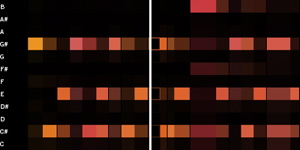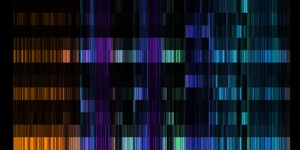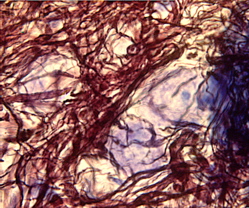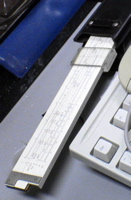Neuron stains
I just got back from a neat lab for my hearing class, in which we got a tour of how to create 3-D models of neurons, see tonotopy in the cortex (with Fos labeling of cells stimulated at particular frequencies), and different types of stains of neurons in the cochlear nucleus.
Joe C. Adams showed us slides demonstrating the various neuron stains in a teaching microscope that had four extra eyepieces connected to it so that all five of us could look at the slides at the same time.
These pictures don’t do the staining justice. The Protargol (reduced silver) stains, which highlight nerve fibers, were so pretty that I wanted to make big prints of them and hang them on my wall. And I was hoping Google would help me find some really beautiful images of these things, but, alas.
I also got a kick out of seeing cartwheel cells, which look like cell bodies with arms coming out in all directions, and when you zoom in and out of the slide, you see new arms coming in and out of focus, making the whole cell look as though it’s spinning. Very cute!
Absolute pitch
Today I had my first known encounter with someone with perfect pitch. We were in my HST class (“Neural Coding and Perception of Sound”), and Bertrand was telling us about an experiment in which the signal was a sine wave “at 200 Hz… No, 220 Hz…” He was playing us the sound on speakers connected to his laptop: beeeeep. “200 or 220, I don’t remember. Anyone with absolute pitch here?”
And the student two seats over raised his hand half-sheepishly, and said, “It’s 220. A little less than 220 actually, but, yeah, 220.”
!!!!
(220 Hz is an A, and 196 Hz is the G right below it.)
!!!!
How research gets done
This morning I had a lab for my class in hearing and perception of sound, at the Research Laboratory of Electronics on the MIT campus. We were doing a lab on “perceptual audio encoding”, which required us to take measurements in soundproof chambers. The place seriously looks like it hasn’t been changed since the 60s. Just when I was thinking, “Hey, this place couldn’t be more outdated even if it had a slide rule!”, I found a slide rule. Here is that slide rule:
And here are some other great futuristic items from the 60s!
Visualizing Music
This is the place to post comments to Visualizing Music, a project I have been working on for the past month or two.


PaRappa the Rapper

Kirthi invited me to play PaRappa the Rapper this afternoon, which is a fun little rhythm game for the PSOne. I played on Easy, which the manual says “is for very young children, or for those who have no sense of rhythm at all.”
Guitar Hero too much
(for Saturday (2/24/07)… it’s just late.)
We have Guitar Hero 2 set up in our lab area (because Alex Rigopulos, of Harmonix, graduated from my group some years ago), and it gets played a LOT. Since there are other groups around us who want to work, we have the game hooked up to two pairs of headphones, so all you can hear when someone is playing is the click-click-clicking of the strumming. Adam says that he plays Guitar Hero so much that he can recognize a piece by the click-click-clicking alone. Amazing, Adam!
This morning, I woke up with a Guitar Hero song stuck in my head. “What song IS that??” I did a search on the web for Guitar Hero, and found a group of guys wrote some software to grab the “tabs” off of Guitar Hero 2. Just by looking at each set of tabs in turn, I was able to find the song (“Less Talk More Rokk”!!), notable for its regular ascending patterns and totally infectious off-beats:

I went on a walk today, across the Mass Ave bridge, up Beacon St, and through the Common to Downtown Crossing. Things I noticed during the walk:
-
People throw phone books on the river. (And why not!)
- My chin is an extremity.
- Today was a good-weather day in Boston. There were people out playing frisbee, kicking a soccer ball around where there wasn’t ice, and joggers all over the place. Today’s low is 17, high is 36, and it’s sunny. Yay!
- The fitting rooms at Filene’s Basement are just one room, lined with mirrors and hooks next to them, spaced about 3 feet apart. After waiting my turn, I walked in, looked around, found the one empty mirror, and squeezed between two naked people to claim it.
The first thing
Choosing something to start with is an intimidating task. I think I’m going to make an allowance that I do not have to choose just one thing each day; rather, I can choose as many as I want. Hooray for more things worth learning!
That said, here is the thing I choose as “the best thing i learned today”:
I’m reading Brian C. J. Moore’s An Introduction to the Psychology of Hearing. In the section entitled “Basic Structure and Function of the Auditory System” (specifically, pp. 22-23 in the 5th edition), Moore discusses the functions of the middle ear (aka those little bones you learned about in elementary school – the hammer, the anvil, and the stirrup). The first function is to transmit sound effectively from the air in the ear canal to the fluid in the cochlea just past your eardrum (it’s an impedance-matcher), which is a really beautiful thing, if you look closely at it.
But the second function, he says, is to “reduce the transmission of bone-conducted sound to the cochlea.” If you’re chewing, the bones in your skull would naturally vibrate, including the bones in your middle ear. These little ear bones would transmit the waves to the cochlea, so these noises would “appear loud and have the effect of masking external sounds.” Bad news. However, the guy who studied all of this, Bárány, showed that the sounds are only transmitted to the cochlea “when there is differential movement between the ossicles and the skull.” Our middle ear is positioned exactly so that it minimizes this possible differential movement. So we can still hear when we’re eating! And, perhaps even more interesting, Moore suggests that birds and reptiles, who have a more simple middle ear that does transmit skull vibrations to the cochlea, “swallow their food whole rather than chewing it, whereas mammals chew their food.”
Wow. I mean, seriously. Is it for real? Only the speculation of science knows!
Close competitors:
- Arrive on time for talks by Edward Tufte, if you really want to see him.
- T stops now appear on Google maps
- A search for “blood blisters” is the second-most common referrer to my website, behind “anita lillie”, so far this month.










